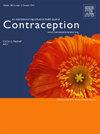限制权利:投票与限制堕胎之间的联系
IF 2.3
2区 医学
Q1 OBSTETRICS & GYNECOLOGY
引用次数: 0
摘要
目的:我们旨在确定州一级的投票限制和堕胎限制之间是否存在关联。当投票障碍增加时,已经被边缘化的人就更难以参与投票并发出自己的声音。其结果是,各国可能进一步远离而不是走向社会和卫生公平。我们假设投票成本较高的州将通过更多的堕胎限制。方法利用古特马赫研究所(Guttmacher Institute)的数据,统计2012年至2021年通过的堕胎限制数量,并将其与2012年、2016年和2020年的投票成本指数(COVI)相结合,该指数根据投票难度对各州进行排名。然后,我们对每个州通过的堕胎限制总数的平均冠状病毒感染排名(1到50,1代表障碍最少的州)进行负二项回归。结果双变量负二项回归结果表明,投票障碍与堕胎限制次数之间存在显著正相关关系。对于平均冠状病毒感染排名得分增加一个单位,我们预计堕胎限制率将增加1.046。因此,我们预测在投票最容易的州有1.72个限制,在投票最难的州有15.8个限制。我们观察到,在投票更难的州,通过堕胎限制的比例更高,这表明对投票权和生育权的攻击是有联系的。本文章由计算机程序翻译,如有差异,请以英文原文为准。
RESTRICTING RIGHTS: THE CONNECTION BETWEEN VOTING AND ABORTION RESTRICTIONS
Objectives
We aimed to determine if an association exists between state-level voting restrictions and abortion restrictions. When barriers to voting increase, it can become more difficult for already marginalized people to access the ballot and make their voices heard. As a consequence, states may move further away from social and health equity rather than toward it. We hypothesize that states with a higher cost of voting will pass more abortion restrictions.
Methods
With data from the Guttmacher Institute, we counted the number of abortion restrictions passed from 2012 to 2021 and combined it with the Cost of Voting Index (COVI) 2012, 2016, and 2020, which ranks each state based on the level of difficulty of voting. We then ran a negative binomial regression of the mean COVI rank (1 to 50, with 1 being the state with the fewest barriers) for each state on the total number of abortion restrictions passed.
Results
The results of the bivariate negative binomial regression indicate a significant positive relationship between barriers to voting and the number of abortion restrictions. For a one-unit increase in mean COVI rank score, we would expect a 1.046 increase in the rate for abortion restrictions. Thus, we predict 1.72 restrictions in the state where it is easiest to vote and 15.8 restrictions in the state where it is hardest to vote.
Conclusions
We observe a higher rate of abortion restrictions passed in states where it is harder to vote, suggesting that attacks on voting rights and reproductive rights are connected.
求助全文
通过发布文献求助,成功后即可免费获取论文全文。
去求助
来源期刊

Contraception
医学-妇产科学
CiteScore
4.70
自引率
17.20%
发文量
211
审稿时长
69 days
期刊介绍:
Contraception has an open access mirror journal Contraception: X, sharing the same aims and scope, editorial team, submission system and rigorous peer review.
The journal Contraception wishes to advance reproductive health through the rapid publication of the best and most interesting new scholarship regarding contraception and related fields such as abortion. The journal welcomes manuscripts from investigators working in the laboratory, clinical and social sciences, as well as public health and health professions education.
 求助内容:
求助内容: 应助结果提醒方式:
应助结果提醒方式:


